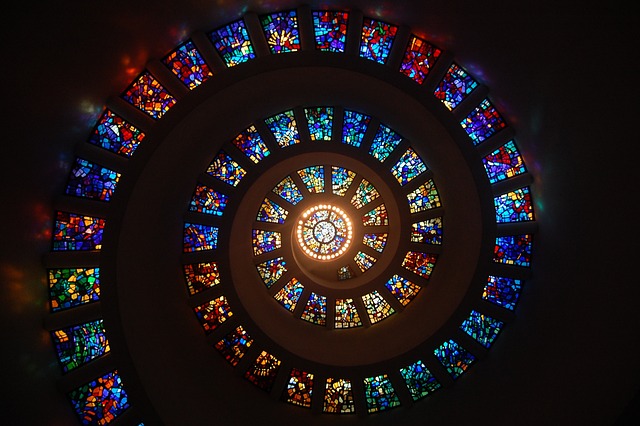The spiritual meaning of the halo is a symbol of divine presence, enlightenment, and holiness. It is often depicted as a radiant circle of light surrounding the head or body of a spiritual or divine being, such as angels, saints, or enlightened individuals. The halo represents a connection to the divine realm, purity, and spiritual enlightenment. It signifies the individual’s elevated spiritual state and their proximity to the divine source of light and love.
Table of Contents
The Symbolism of the Halo in Religious Art
Have you ever wondered about the meaning behind the halo often depicted in religious art? The halo, a radiant circle of light surrounding the head of a figure, holds deep spiritual significance in various religious traditions. It is a symbol that has been used for centuries to represent divinity, enlightenment, and the sacred nature of the depicted figures.
In Christian art, the halo is commonly associated with saints, angels, and Christ himself. It is believed to represent the divine light and grace that emanates from these holy beings. The halo serves as a visual representation of their spiritual purity and connection to the divine. It is a way to visually distinguish them from ordinary mortals and to emphasize their elevated status.
The origins of the halo can be traced back to ancient civilizations such as Egypt and Greece, where it was used to depict gods and goddesses. In these cultures, the halo symbolized the divine nature and power of these deities. As Christianity spread throughout the world, the halo was adopted and adapted to fit the new religious context.
In addition to its association with divinity, the halo also carries a deeper spiritual meaning. It represents the inner light and enlightenment that can be achieved through a deep connection with the divine. The halo serves as a reminder that we all have the potential to cultivate our own inner light and to strive for spiritual growth and enlightenment.
The halo is not limited to Christian art; it can also be found in other religious traditions. In Hinduism, for example, the halo is known as the “aura” or “nimbus” and is often depicted surrounding the heads of gods, goddesses, and enlightened beings. It represents their divine energy and spiritual power.
Similarly, in Buddhism, the halo is known as the “mandorla” and is often depicted surrounding the figures of Buddhas and bodhisattvas. It symbolizes their awakened state and their ability to radiate compassion and wisdom to all beings.
The halo is not just a visual element in religious art; it also has a profound impact on the viewer. When we see a figure depicted with a halo, it can evoke a sense of awe, reverence, and spiritual connection. It serves as a reminder of the divine presence that exists within and around us.
The halo also invites us to reflect on our own spiritual journey. It reminds us that we are all capable of embodying the qualities represented by the halo – love, compassion, wisdom, and divine grace. It encourages us to strive for spiritual growth and to cultivate our own inner light.
In conclusion, the halo holds deep spiritual significance in religious art. It represents divinity, enlightenment, and the sacred nature of the depicted figures. Whether it is found in Christian, Hindu, or Buddhist art, the halo serves as a visual reminder of the inner light and spiritual potential that exists within each of us. It invites us to connect with the divine and to strive for spiritual growth and enlightenment. So, the next time you come across a figure with a halo in a painting or sculpture, take a moment to reflect on its deeper meaning and the spiritual journey it represents.
The Halo as a Representation of Divine Light

Have you ever wondered about the spiritual meaning behind the halo? You may have seen it depicted in religious art, often as a golden circle surrounding the heads of saints, angels, and other divine figures. The halo has a deep significance in many spiritual traditions, representing the presence of divine light.
In Christianity, the halo is often associated with the concept of divine radiance. It is believed to symbolize the holiness and purity of those who are in the presence of God. The halo is seen as a manifestation of the divine light that shines from within these individuals, illuminating their souls and making them appear almost ethereal.
The use of the halo in Christian art dates back to the early centuries of the Church. It was a way for artists to visually represent the spiritual nature of the figures they were depicting. By placing a halo around a person’s head, they were indicating that this individual had a special connection to the divine.
The halo is not exclusive to Christianity, however. It can also be found in other religious traditions, such as Buddhism and Hinduism. In these traditions, the halo is often associated with enlightenment and spiritual awakening. It represents the inner radiance that is achieved through deep spiritual practice and the attainment of higher states of consciousness.
In Buddhism, for example, the halo is known as the “aura” or “nimbus.” It is believed to be a visible manifestation of the individual’s spiritual energy, or “chi.” The halo is seen as a sign of spiritual purity and enlightenment, indicating that the person has transcended the limitations of the physical world and achieved a higher level of consciousness.
Similarly, in Hinduism, the halo is known as the “prabha” or “divya-chakshu.” It is associated with the divine light that radiates from the enlightened beings, known as “avatars” or “gurus.” The halo is seen as a symbol of their spiritual power and wisdom, as well as their ability to guide others on the path to enlightenment.
While the halo is often depicted as a golden circle, it can also take on different forms and colors, depending on the tradition and the individual’s spiritual state. In some cases, it may appear as a radiant light surrounding the entire body, while in others, it may be depicted as a series of rays or flames emanating from the head.
Regardless of its form, the halo serves as a reminder of the divine presence within each of us. It is a symbol of our own potential for spiritual growth and enlightenment. Just as the halo represents the inner radiance of the saints and enlightened beings, it also reminds us that we too have the capacity to cultivate our own inner light and connect with the divine.
So, the next time you come across a depiction of a halo in religious art, take a moment to reflect on its spiritual meaning. Allow it to serve as a reminder of the divine light that resides within you and the potential for spiritual growth that exists in all of us. Embrace your own inner halo and let it guide you on your own journey towards enlightenment.
Exploring the Halo as a Sign of Holiness and Sanctity
Have you ever wondered about the spiritual meaning behind the halo? You may have seen it depicted in religious art, often as a golden circle surrounding the heads of saints, angels, and other divine figures. The halo has long been associated with holiness and sanctity, but what exactly does it symbolize?
In many religious traditions, the halo is seen as a visual representation of a person’s spiritual aura or divine light. It is believed to be a radiant glow that emanates from those who are deeply connected to the divine. This radiant light is said to be a reflection of the person’s inner purity and their close relationship with the divine.
The halo is often depicted as a golden circle, symbolizing the divine light that shines from within. Gold has long been associated with divinity and is seen as a precious metal that represents purity and perfection. By surrounding the heads of holy figures with a golden halo, artists aim to convey their elevated spiritual status and their connection to the divine.
In addition to its association with holiness, the halo is also seen as a symbol of enlightenment and spiritual awakening. It represents the illumination of the mind and the expansion of consciousness. Those who have achieved a higher level of spiritual awareness are believed to radiate this inner light, which is symbolized by the halo.
The halo is not limited to religious figures alone. In some spiritual traditions, it is believed that every person has the potential to develop their own halo through spiritual practice and self-realization. By cultivating virtues such as love, compassion, and kindness, individuals can awaken their inner light and become beacons of divine energy.
The halo is not just a symbol of individual spiritual attainment; it also represents the interconnectedness of all beings. It reminds us that we are all part of a greater whole and that our actions and thoughts have an impact on the world around us. Just as the halo radiates light, our own actions and intentions can have a ripple effect, spreading positivity and love to those we encounter.
The halo serves as a reminder to strive for spiritual growth and to align ourselves with higher principles. It encourages us to cultivate virtues and to live in harmony with the divine. By doing so, we can awaken our own inner light and become a source of inspiration and guidance for others.
In conclusion, the spiritual meaning of the halo goes beyond its depiction in religious art. It symbolizes the inner radiance and divine connection of holy figures, as well as the potential for every individual to cultivate their own halo through spiritual practice. The halo represents enlightenment, interconnectedness, and the power of our actions to create positive change in the world. So, let the halo serve as a reminder to nurture your own inner light and to strive for spiritual growth in your own life.
The Halo’s Connection to Spiritual Enlightenment and Ascension
The halo is a symbol that has been used in various religious and spiritual traditions throughout history. It is often depicted as a golden circle of light surrounding the head of a divine being or a saint. But what is the spiritual meaning behind this iconic symbol?
The halo is believed to represent spiritual enlightenment and ascension. It is a visual representation of the divine light that radiates from within an enlightened being. In many religious traditions, the halo is associated with the highest level of spiritual attainment and is seen as a sign of divine favor.
In Christianity, the halo is commonly associated with angels and saints. It is believed to be a manifestation of the divine grace and presence. The halo is often depicted as a radiant circle of light, symbolizing the purity and holiness of the individual it surrounds. It serves as a reminder of the spiritual journey and the ultimate goal of union with God.
Similarly, in Buddhism, the halo is known as the “aura” or “nimbus.” It is believed to be a manifestation of the individual’s spiritual energy and enlightenment. The halo is often depicted as a glowing circle or a series of concentric rings, symbolizing the expansion of consciousness and the attainment of higher states of being.
In Hinduism, the halo is known as the “prabha” or “divya-chakshu.” It is associated with the divine light and the awakening of the inner self. The halo is often depicted as a luminous aura surrounding the head of a deity or an enlightened being. It represents the individual’s connection to the divine and their ability to transcend the limitations of the physical world.
The spiritual meaning of the halo goes beyond religious symbolism. It is a reminder of our own potential for spiritual growth and transformation. The halo serves as a beacon of light, guiding us on our spiritual journey and reminding us of the divine spark within.
To experience the spiritual meaning of the halo, one must cultivate a deep sense of inner awareness and connection to the divine. This can be achieved through various spiritual practices such as meditation, prayer, and self-reflection. By quieting the mind and opening the heart, we can tap into the divine light that resides within us and allow it to shine brightly.
The halo also serves as a reminder of the interconnectedness of all beings. It symbolizes the unity and oneness of the spiritual realm. Just as the halo surrounds the head of a divine being, we are all connected to the divine source of light and love. The halo reminds us that we are not separate from each other or from the divine, but rather, we are all part of a greater whole.
In conclusion, the spiritual meaning of the halo is one of enlightenment and ascension. It represents the divine light that radiates from within an enlightened being and serves as a reminder of our own potential for spiritual growth. The halo symbolizes the unity and interconnectedness of all beings and serves as a guide on our spiritual journey. By cultivating inner awareness and connection to the divine, we can experience the spiritual meaning of the halo and allow our own inner light to shine brightly.
Conclusion
The spiritual meaning of the halo is often associated with divine presence, enlightenment, and holiness. It symbolizes the radiance and purity of a spiritual being, representing their connection to the divine and their elevated state of consciousness. The halo is commonly depicted in religious art to signify the divine nature and spiritual enlightenment of saints, angels, and other revered figures. It serves as a visual representation of their spiritual aura and their close proximity to the divine realm. Overall, the halo holds a significant spiritual meaning, representing the embodiment of divine light and spiritual transcendence.


